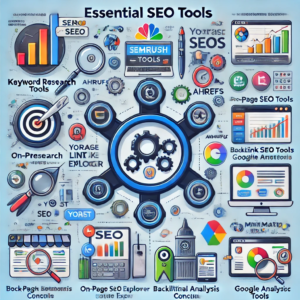Local SEO has never been more important for small businesses. With consumers increasingly relying on search engines to find nearby services, ensuring your business ranks well in local search results can be the difference between thriving and being overlooked.
As algorithms evolve, including updates like Google’s Helpful Content Update, mastering local SEO means focusing on user-first strategies and staying ahead of trends.
This guide dives deep into the essentials of local SEO in 2024, highlighting actionable tips, key ranking factors, and common mistakes to help your business grow its local visibility.

Key Local SEO Ranking Factors in 2024
1. Google My Business (GMB) Optimization
Your GMB profile is often the first interaction customers have with your business. A well-optimized GMB profile boosts your chances of appearing in Google’s Local Pack (the map section).
- Action Steps:
- Claim and verify your GMB listing.
- Add up-to-date details like address, phone number, hours, and services.
- Post regular updates and upload photos to keep the profile engaging.
2. NAP Consistency
NAP stands for Name, Address, and Phone number. Google looks for consistency across all online platforms to verify your business’s legitimacy.
- Action Steps:
- Use tools like BrightLocal or Moz Local to identify discrepancies in listings.
- Update incorrect or outdated information across directories like Yelp, Bing, and Yellow Pages.
3. Customer Reviews and Ratings
Reviews significantly impact local SEO rankings and customer trust. Google favors businesses with positive, frequent reviews.
- Action Steps:
- Encourage happy customers to leave reviews on Google.
- Respond to reviews—both positive and negative—to show engagement and professionalism.
4. Localized Content
Creating content tailored to your local audience helps improve rankings and engages potential customers.
- Action Steps:
- Write blog posts or guides about local topics (e.g., “Top 10 Coffee Shops in [City]”).
- Use local keywords naturally within your content.
5. Mobile Optimization
Most local searches happen on mobile devices. A mobile-friendly website ensures users stay engaged.
- Action Steps:
- Use Google’s Mobile-Friendly Test tool to evaluate your site. (note: the tool has since been retired but you can still test for mobile friendly site using the link provided.)
- Optimize loading speeds and ensure easy navigation on small screens.
6. Backlinks from Local Sites
Backlinks from trusted local websites signal relevance to search engines.
- Action Steps:
- Partner with local organizations or sponsors for events.
- Get featured in local news articles or blogs.

Tools for Local SEO Success
- Free Tools:
- Google My Business: Essential for managing your online profile.
- Google Analytics: Tracks user behavior and performance metrics.
- Search Console: Monitors search visibility and technical issues.
- Paid Tools:
- BrightLocal: Local SEO audits and citation management.
- Moz Local: Automated listing updates across platforms.
- SEMrush: Comprehensive SEO insights, including local performance.
Actionable Strategies for Small Businesses
- Claim and Optimize Your Google My Business Listing
- Complete every section of your profile.
- Add high-quality photos and encourage users to upload theirs.
- Respond to reviews professionally and promptly.
- Use relevant keywords in your business description.
- Create Hyper-Local Content
- Focus on specific neighborhoods or cities.
- Use geo-targeted keywords in blogs and articles.
- Share success stories from local customers.
- Example: “How [Your Service] Helps Residents of [Neighborhood].”
- Leverage Local Events
- Sponsor or write about community events to boost visibility.
- Partner with other local businesses for mutual promotions.
- Share event recaps on your website and social media.
- Example: “Why We’re Excited to Sponsor [Event] in [City].”
- Engage on Social Media
- Post about local topics and interact with customers in your area.
- Join community groups relevant to your business.
- Share behind-the-scenes content highlighting your local presence.
- Use local hashtags to increase post visibility.
- Ask for Reviews
- Politely ask satisfied customers to leave reviews.
- Provide direct links to review pages in follow-up emails.
- Highlight positive reviews on your website and social media.
- Offer incentives like discounts for verified reviews (if allowed).
- Run Local Ad Campaigns
- Use Google Ads to target specific geographic areas.
- Create location-specific ad copy and landing pages.
- Set up Facebook Ads targeting local audiences.
- Monitor and adjust campaigns based on local performance metrics.
Measuring Your Local SEO Performance
- Metrics to Track:
- Traffic from local searches (Google Analytics).
- Engagement on GMB (views, clicks, calls).
- Conversion rates from local campaigns.
- How to Improve:
FAQs About Local SEO
1. What is the best way to optimize for “near me” searches?
To optimize for “near me” searches, ensure your website is mobile-friendly and responsive. Use local keywords throughout your site, including in meta descriptions, headers, and content.
Keep your Google My Business (GMB) profile updated with accurate contact information, business hours, and a clear business description. Regularly post updates and engage with customer reviews on GMB to boost visibility.
2. How can I encourage more customer reviews?
Encouraging customer reviews can be done by offering small incentives such as discounts, loyalty points, or exclusive perks.
After completing a transaction, send follow-up emails with direct links to your review pages on Google, Yelp, or other relevant platforms.
Train your staff to ask satisfied customers for reviews politely.
3. Does social media activity affect local SEO?
Yes, social media activity can impact local SEO positively. Active engagement on platforms like Facebook, Instagram, and LinkedIn helps build your online presence and increase brand visibility.
Share location-specific content, promote special offers, and respond to comments and messages promptly to build trust and encourage user interactions.
4. How do I fix inconsistent NAP listings?
NAP stands for Name, Address, and Phone number. Inconsistent NAP listings can confuse search engines and reduce your local SEO effectiveness.
Use citation management tools like Moz Local, Yext, or BrightLocal to identify and correct errors.
Regularly audit your online listings and update any outdated information across directories and social platforms.
5. Is it worth investing in paid local SEO tools?
Investing in paid local SEO tools can be worthwhile, especially if your business operates in a competitive market.
Tools like BrightLocal, SEMrush, or Whitespark provide valuable insights, including keyword tracking, competitor analysis, and citation management.
These tools save time and streamline the process of enhancing local search visibility.
Conclusion
Local SEO is a game-changer for small businesses in 2024. By optimizing for local searches, engaging with your community, and staying consistent across platforms, you can dominate your local market. Start small by enhancing your Google My Business profile and building on these strategies over time.
With a little effort, your business can rank high, attract more customers, and thrive in today’s competitive digital landscape.
Article you might be interested in; Google’s Helpful content update, (Learn More)






